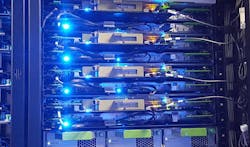IoT & AI Changing the Face of Data Centers as 2020 Nears
Marc Cram, Director of Sales for Server Technology, explores how the data demands and more of the IoT and AI are changing the tech and data center industry. Explore what’s in store for 2020, right around the corner.
Marc Cram, Director of Sales, Server Technology
In the world of 2019, we are living on the cusp of a major uptake in advanced technologies that promise to bring new levels of prosperity and convenience to people around the globe. The buildout of 5G wireless and fiber networks will create new jobs and new business models while enabling the transport of the anticipated tsunami of data coming from the uptake of IoT sensors, 5G-enabled handsets, and smart city efforts. Artificial intelligence (AI) will be deployed in countless IoT applications and locations to selectively route data traffic, provide spoken language interfaces, and optimize energy consumption.
As we approach 2020, we are already seeing open source software stacks that run on open hardware platforms to deliver edge computing, cloud computing, open radio access networks (O-RAN), IoT applications and artificial intelligence. Kubernetes, Akraino, and TensorFlow are but a few examples of the software efforts deployed or under way. The Open Compute Project (OCP) has become the leading repository for open source hardware designs donated by companies such as Facebook, Microsoft and Google.
The number and variety of sensors and devices having onboard wired or wireless connectivity supporting IPv4 and IPv6 continues to grow at an accelerating pace. Semiconductor companies are enabling a wide variety of protocols for putting things onto a network, such as Zigbee, Z-Wave, Bluetooth, LowPAN, LoRa, LoRaWAN, NFC, Wi-Fi6, LTE, 5G, and 10/100/1000 ethernet.
As smart cities seek to provide greater amounts of data and convenience applications for their citizens, sensors will be deployed to monitor ever wider swaths of infrastructure (Image: Server Technology)
So far, every software application has to run on a power-consuming hardware device, and most data generating sensors consume power. Until the gene twisters of the world figure out how to embed Wi-Fi or some other low-power networking interface into our DNA, communicating with these devices and sensors will continue to require handheld or other mobile power-consuming electronics of some sort to deliver meaningful, actionable intelligence to the individual. Cell phones take DC power in, and consume DC power as they display email or stream video. Edge and cloud servers take AC or DC power in, and consume DC power at the CPU to serve web pages and play online games. Networking hardware takes in AC or DC power, and consumes DC power in order to route and switch data between ports and the internet.
As smart cities seek to provide greater amounts of data and convenience applications for their citizens, sensors will be deployed to monitor ever wider swaths of infrastructure: water, sewer, electric, lighting, bridges, road conditions and pothole locations, street parking, park occupancy, public restrooms availability, escalator and elevator availability, door access, subway and light rail schedules, bus schedules, delivery drone locations, and active signage status will all be available to everyone, 24 hours a day.
The number and variety of sensors and devices having onboard wired or wireless connectivity supporting IPv4 and IPv6 continues to grow at an accelerating pace.
5G-enabled smartphones will embed dedicated AI chips to improve the quality of spoken interfaces and optimize battery life. New sensors in the smartphone will provide more detailed health and wellness data, while new software applications will deliver heretofore unrivaled experiences through augmented and virtual reality.
Each new application, each piece of information, takes electrical power to be created, transported, stored, analyzed and displayed. At Legrand, we are committed to provide sustainable power, access, and control solutions for the edge, cloud, core, mobile and smart city infrastructure used daily by billions of people around the world.
Marc Cram is Director of Sales for Server Technology.


